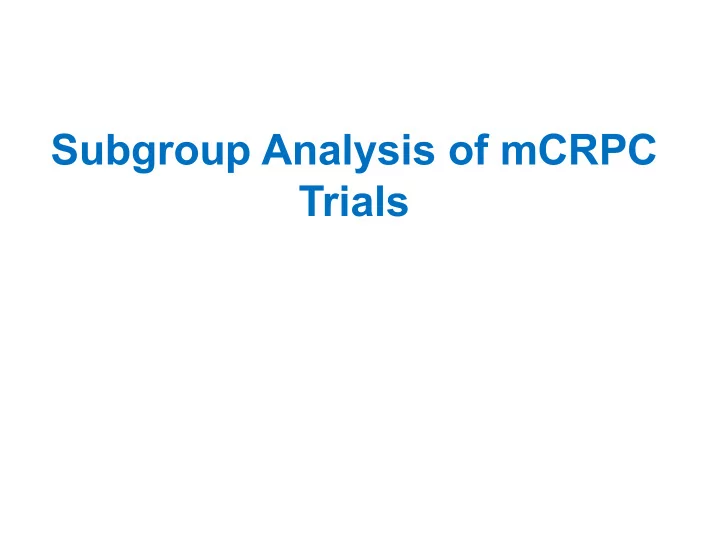

Subgroup Analysis of mCRPC Trials
Conflict of Interest None
General Assumption • Hypothesis tested usually address an overall or ‘average’ treatment effect in the study population • No assumption of homogeneity of effect across subgroups
The Challenge Applying overall results Danger of subgroup of large trials to individual analysis patients
Subgroup Analyses - Pervasive in Clinical Trials • Positive trial –To characterize patients who benefit from the therapy vs. those who may not • Negative trial –To identify at least some patients with treatment benefit
Positive Trial: ENZAMET Davis et al, NEJM 2019
Positive Trial: ENZAMET Davis et al, NEJM 2019
Negative Trial: PROSTVAC Gulley et al, JCO 2019
Negative Trial: PROSTVAC Gulley et al, JCO 2019
Warning: Subgroup Analysis • A machine for producing false negative and false positive results. Peto et al., Br. J. Cancer 1977
1. Type I Error Rate Error rate as a function of number of subgroups 1 0.9 Type I error rate 0.8 0.7 0.6 0.5 0.4 0.3 0.2 0.1 0 0 10 20 30 40 50 60 70 80 90 100 Number of mutually exclusive subgroups (k) k=5, probability is 0.23 that one comparison p-value <0.05 k=10, probability is 0.40 at least one comparison p-value <0.05
Positive Trial: ENZAMET Davis et al, NEJM 2019
2. Power Is An Issue Don’t Be Misled Ratio of Subgroup Power (90%) Power Events/ Total Events (85%) 1 0.90 0.85 0.75 0.83 0.74 0.50 0.63 0.56 0.40 0.54 0.47 0.30 0.43 0.37 Hazard ratio=0.75
3. A Mistake to Avoid • An incorrect inference that a subgroup effect is present based on separate tests of treatment effects within each level of the characteristic of interest, that is, to compare one significant and one non-significant p- value
Subgroup Analyses P-value for interaction
Criteria to Assess Credibility of Subgroup Analyses • Can chance explain the apparent subgroup effect? • Is treatment effect consistent? • Was the subgroup hypothesis one of a small number of hypotheses developed a-priori with direction specified? Sun et al, JAMA 2014
Criteria to Assess Credibility of Subgroup Analyses • Is there strong preexisting biological support? • Is the evidence supporting the effect based on within- or between-study comparisons? Sun et al, JAMA 2014
Positive Trial: ENZAMET Davis et al, NEJM 2019
Negative Trial: PROSTVAC Gulley et al, JCO 2019
Level Of Evidence Post-Hoc Pre-specified subgroups A-Priori Designed Treatment-Subgroup Interaction
Safeguards: Design and Analysis Phase • Clear description of hypothesis: direction • Limit number of subgroup testing • Statistical test of treatment-subgroup interaction • Subgroup a stratification variable Yusuf et al, JAMA 1991
Safeguards: Interpretation • Greater emphasis on the overall result than a subgroup • test of treatment-subgroup interaction rather than treatment effect within subgroups • Interpret the results in the context of other trials principles of biological rationale and coherence
Conclusion • Best statistical design - Answer primary question - Feasible • Planning is key -Avoid “statistical sins” • Pre-specified subgroup is better than post- hoc
Conclusion • Larger studies are needed for treatment- subgroup interaction • Meta-analysis plays critical role
A Final Note “Rather than reporting isolated P values, articles should include effect sizes and uncertainty metrics.” Waaserstein R, American Statistician 2016
Recommend
More recommend